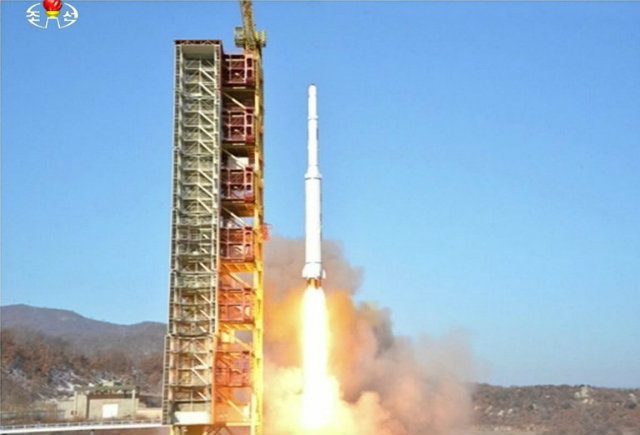SUMMARY
This is AI generated summarization, which may have errors. For context, always refer to the full article.

SEOUL, South Korea – Official moves towards the deployment – fiercely opposed by China – of a US missile defense system in South Korea highlight the inherent dangers of disunity in dealing with North Korea’s growing military threat, analysts say.
Hours after North Korea’s long-range rocket launch on Sunday, February 7, South Korean and US military officials announced they would begin formal discussions on placing the Terminal High Altitude Area Defense System (THAAD) on the North’s doorstep.
The rationale was a clear necessity to upgrade the defense posture of the South Korea-US military alliance “against North Korea’s advancing threats,” said Yoo Jeh-Seung, Seoul’s deputy defense minister for policy.
Yoo’s reasoning is hard to fault in the wake of the North’s fourth nuclear test on January 6 and Sunday’s rocket launch, which was widely regarded as a covert ballistic missile test.
“This nuclear testing coupled with the testing of ballistic missile technology … was always likely to strengthen the argument that South Korea needs to bolster its missile defences,” said Ben Goodlad, principal weapons analyst at IHS Aerospace, Defense and Security.
But beyond the strategic logic lies a diplomatic imperative, which suggests an eventual THAAD deployment may be less motivated by what North Korea is doing and more by what China is not doing.
China consequences
China is North Korea’s main diplomatic protector, and both Washington and Seoul have been pressing Beijing to take a tougher line with Pyongyang over its nuclear weapons program.
But China, wary of the consequences of a collapsing North Korea on its border, has resisted punitive sanctions before, and looks set to do so again as the UN Security Council debates its response to Pyongyang’s latest provocations.
According to Joel Wit, a senior fellow at the US-Korea Institute at Johns Hopkins University and the founder of its North Korea website, 38North, frustration with China’s stance has driven forward the possibility of deploying THAAD in South Korea.
“This is a way of sending a signal to China that what North Korea does has real consequences, including consequences for Beijing’s own security interests,” Wit said.
China’s response to that signal was swift and unequivocally negative.
While it only managed a rather muted expression of “regret” over the North’s rocket launch, it was quick to voice its “deep concern” at the prospect of South Korea introducing the US missile system.
Beijing’s warnings
Chinese Foreign Ministry spokeswoman Hua Chunying said such a move would escalate tensions on the Korean peninsula, undermine regional peace and stability, and set back efforts to address the North Korean nuclear situation.
“We demand the countries concerned be prudent,” Hua said.
China sees THAAD as a threat to the effectiveness of its own nuclear deterrent, arguing that it could be used to monitor Chinese missile launches as far inland as Xian in the northwest.
China is South Korea’s most important trade partner and – in deference to Beijing’s sensitivities on the issue – South Korea had, until now, declined to formally discuss bringing in THAAD.
Instead it had concentrated on developing an indigenous missile defense system for intercepting short to medium range ballistic missiles, using primarily Patriot-type interceptors.
At the same time, South Korean President Park Geun-Hye has made strenuous diplomatic efforts to court China, building a personal rapport with President Xi Jinping in the hope of developing a genuine strategic partnership.
Ties have significantly improved as a result but, on the key issue of dealing with North Korea, Park’s diplomatic initiative has not achieved the desired results.
The net result, after the North’s latest nuclear test and rocket launch, is the opening of formal talks on THAAD deployment.
Disunity dangers
“It’s a message to China that if you won’t deal with North Korea, we will go our way,” said Paul Carrol, program director for the nuclear disarmament and global security organization Ploughshares Fund.
“And clearly there’s a danger there, because unless China and the US can get on the same page with a common approach to North Korea, there won’t be any progress and the situation will only get worse,” Carroll said.
“THAAD is partly about the US reassuring South Korea that it has its back, but at the same time there must be a broader picture discussion with China about how to handle North Korea,” he added.
There is already a THAAD battery stationed in Guam and the other key US ally in the region, Japan, is also considering taking on the system.
“The pressure for the US to reaffirm and extend its deterrent protection to its allies is only going to grow, and there’s a real potential for regional tension and instability there,” said Wit.
“Instead of curbing North Korea’s nuclear ambitions, we get an arms build-up instead,” he added. – Giles Hewitt, AFP / Rappler.com
Add a comment
How does this make you feel?
There are no comments yet. Add your comment to start the conversation.